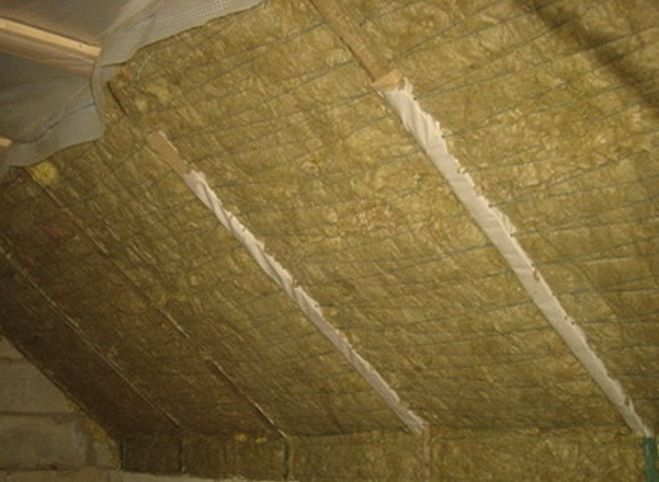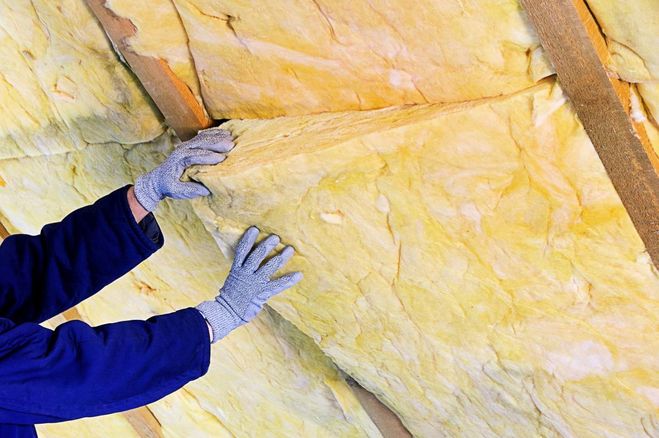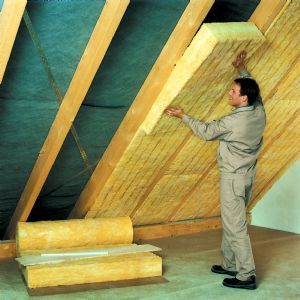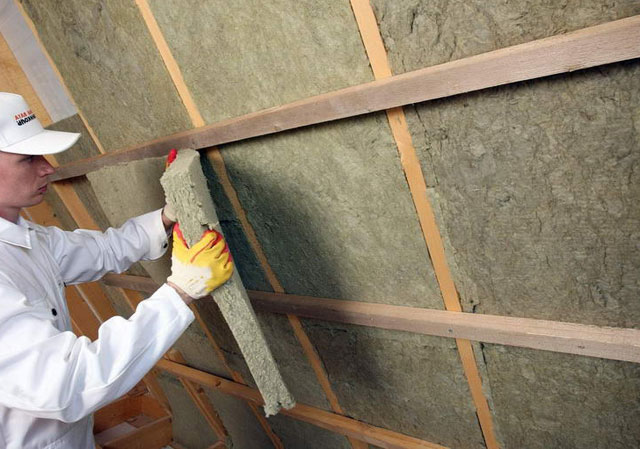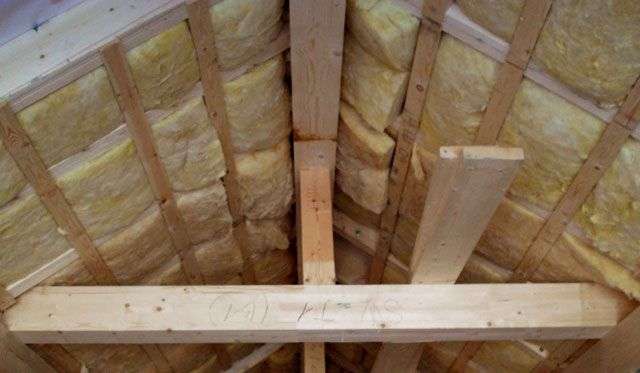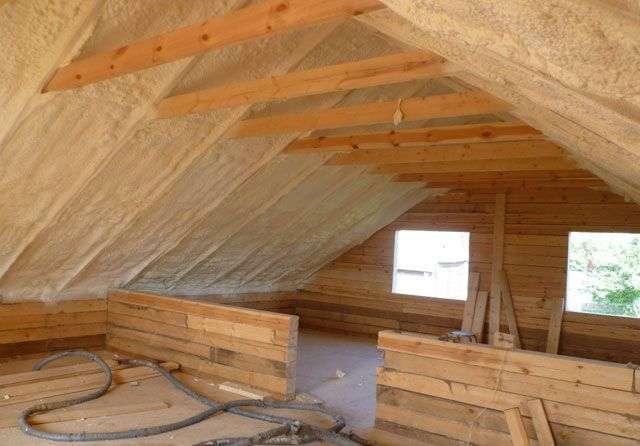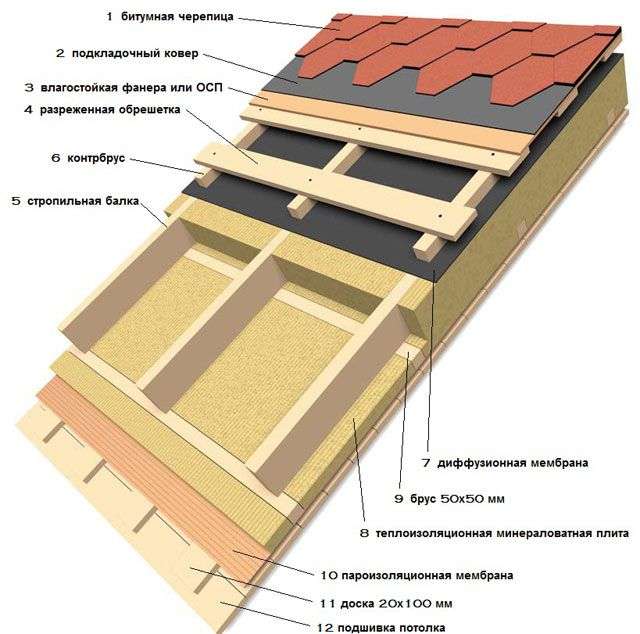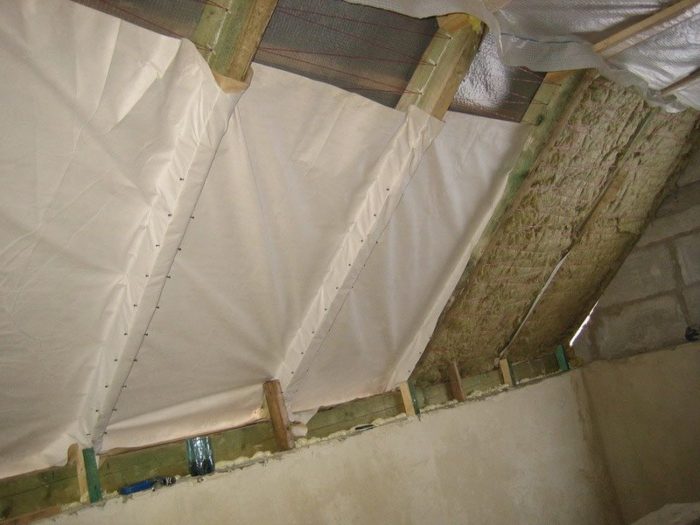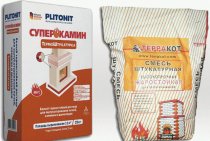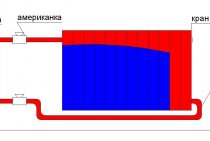The choice of insulation
Before starting the installation of a roofing pie, you need to decide what materials you will use for insulation. The number of layers and the thickness of the thermal insulation directly depend on this. The most popular materials are:
- Polyurethane foam.
- Extruded polystyrene foam.
- Glass wool.
- Mineral wool.
- Less commonly used foamed glass or natural insulation in the form of wood chips, granulated paper, and so on.
Parameters that you should pay attention to when choosing a heater:
- Thermal conductivity (coefficient).
- Moisture resistance.
- Fire resistance.
- Eco safety.
The higher the moisture resistance of the material, the longer such a heater will last. The fire rating is the most important criterion for meeting fire safety requirements. The last two parameters determine how safe and environmentally friendly the insulation is for humans. These indicators in no way affect the effectiveness and durability of the material.
How to fix mineral wool insulation between wooden rafters
Mineral wool insulation between the rafters can be fixed in several ways. One of the most common is the laying of slabs or cut sheets between the rafters without fastening. In this case, the distance between the rafters should be 2-3 centimeters of the width of the insulation. Mineral wool is laid tightly, with little tension.
Before laying, the mineral wool is unpacked and given time to lie down, take the desired shape, and then cut into slabs or canvases of the desired size. It is imperative to work with mineral wool in special clothing that fits snugly to the body so that the microparticles do not get on unprotected areas of the skin, and of course put on gloves on your hands and a respirator on your face.
The first described method of laying mineral wool is reliable if the thickness of the insulation boards is not more than 10 centimeters. Often the attic room is insulated with several layers of mineral wool and the slabs can fall out during work from the space between the rafters (and the force of attraction to the ground acts on the insulation). The heater requires additional fixing.
You can fix the insulation with a large number of rails. And it is best to do this with a nylon thread or polymer twine, or soft steel wire. To do this, stuff carnations along the rafters and then pull the thread or twine in a zigzag. Instead of nails, you can thread, fasten the twine immediately to the rafters with staples. The distance between the fasteners is not more than 20 centimeters. The insulation, fixed in this way in the opening between the rafters, will be securely fixed.
Mineral wool is laid between the rafters without additional fastening.
In order to avoid problems with the installation of mineral wool, it is necessary to measure the distance between the rafters.
Mineral wool is cut in such a way that its width is greater than the step between the rafters, two more, or even three cm.
From the bottom of the rafters, before installing mineral wool, a crate is stuffed.
The laid mineral wool + crate that holds it is the so-called "fastening" of mineral wool.
Prior to the installation of the roofing material, a waterproofing film with a slight sag and overlap is attached on top of the mineral wool.
The film is attached to the rafters with staples and a stapler.
From the bottom of the crate, a vapor barrier is mounted that will protect the mineral wool from fumes coming from a warm room.
Steam insulation can be glassine (the most inexpensive option.
Glassine is also fastened with staples to the crate.
Next, the counter-batten and installation of the finishing material.
If you fasten mineral wool on the inside of the roof (for example, you insulate the attic), then in this case, mineral wool is tightly (vspor) placed between the rafters,
but before its installation we fix the waterproofing, after the vapor barrier.
In some cases, twine is used with which you can keep the mineral wool between the rafters.
Preliminarily, taking into account the thickness of the insulation, nails are hammered into the side of the rafters.
Then the twine is pulled (thin wire and fishing line are also suitable).
Warming in a combined way
Combined insulation increases the resistance of the surface to heat loss. In this case, it is possible to use materials with different characteristics, comprehensively protecting the roof. In this case, the cost of work increases. But shortening the payback period brings the technology to the level of the most used one.
Often, two-layer insulation is carried out in the distances between the rafters and on top of them. Inside, light and soft mineral wool boards are used. They provide basic thermal protection by keeping the heat inside the room.
Rigid slab insulation is mounted on top of the rafters. Basically, wood-fiber boards are used for its device. The joints of the plates should fall on the rafter leg. In this case, the fastening of the products will be ensured and the blowing of the seams will be excluded.
This method is convenient when repairing a roof or overlapping it. The old insulation is left if it meets its functions. Also, an additional layer of insulation neutralizes the voids inside the main protection.
The combined thermal protection between the rafters and indoors is quite effective. As internal insulation is used:
- cork cloth or plates;
- penofol;
- drywall.
Rolled rafter insulation materials are attached to them using wooden slats. It is better to use polyethylene foam substrates. They do not let steam through, thereby providing reliable protection for the next layer. The most used are products with a reflective layer. Foil coating allows you to keep warm inside with a minimum thickness of insulation.
Plasterboard insulation requires the creation of a frame. In addition, the sheets have a certain width, which you need to count on. But drywall will provide at the same time and noise protection
This is especially important when installing metal tiles.
The most effective is three-layer insulation. In this case:
rafters are closed from internal and external influences;
high-quality noise protection is provided;
due to overlapping layers of joints of materials, complete thermal sealing of the room is ensured;
installation defects of one layer are compensated by the correct arrangement of the other two
This is important for additional insulation during roof repairs. This scheme is used in Germany for the construction of houses called Passivhaus
In such houses there is no need for heating or the cost of it is minimal. According to the standard, they are 10% of the energy consumption of a conventional home.
This scheme is used in Germany for the construction of houses called Passivhaus. In such houses there is no need for heating or the cost of it is minimal. According to the standard, they are 10% of the energy consumption of a conventional home.
When installing thermal insulation, it is worth remembering that the work belongs to a hidden cycle. Correctness of execution cannot be verified after finishing. Therefore, it is worth choosing only high-quality materials for roof insulation between the rafters and comply with all installation requirements.
Insulation between rafters
The traditional way to insulate a sloping roof is to place the insulation between the rafters. In this case, you can arrange a flat ceiling of the attic room.
Before starting the insulation, you need to mount a waterproof film over the rafters.It will protect the room from possible precipitation and will allow you to work in any weather. It is better to choose a diffusion membrane. When installing a micro-perforated or anti-condensation coating, a two-sided gap is arranged. Condensation often forms on films. His hit on the heater:
- increase the coefficient of thermal conductivity;
- lead to damage to the insulation;
- contributes to the development of mold;
- reduce the bearing capacity of roofing elements.
The insulation is not laid to the full height of the rafter leg. A gap of 2-3 cm is enough to ensure the flow of air and natural drying.
With this technology, low-density insulation is often used. For proper operation, such heaters need to be additionally fixed, which leads to an overrun of the frame material.
Often soft insulation shrink during operation. Deformations occur both in width and in height. As a result, some areas are exposed, becoming defenseless against the cold.
It is not recommended to use insulation in the form of dense materials: polystyrene foam, polyurethane foam. Due to the instability of dimensions, gaps form between the rafters and the slabs. The use of mounting foam does not save the situation. Blowouts are formed.
Mineral wool thermal insulation Stone (basalt) wool Glass wool
Mineral wool of a slab type is best suited for insulation inside the rafters. When laying, the joints of the plates are shifted by half the width of the product. In this case, the appearance of cold bridges is prevented.
The dressing of the seams is also important with multi-layer styling. The next product should overlap the seams of the previous flooring. For multi-layer laying, products of maximum thickness are used. For example, for insulation with a layer of 150 mm, it is better to take a material of 100 and 50 mm than three plates of 50 mm each.
With a slope angle of less than 30 °, an additional frame is arranged under the insulation. It will prevent the plates from slipping and caking. The frame holds the boards in their mounting position during their entire service life.
The accepted width of the slabs should be 1-1.5 cm more than the clear distance between the rafters. In this case, a tight fit will be ensured. With a smaller width, gaps will occur due to defects in wood or oversight of builders. Large thickness contributes to the deformation of the plate and its bending.
Inside the insulation of pitched roofs on wooden rafters, there should be no air gaps and cracks. Layers should adjoin each other tightly. This also applies to interlayer spaces and joints. Professionals lay the plates, cutting them into two trapezoidal parts.
Polyurethane foam (PPU)
Another innovative way of insulation is polyurethane foam. It is possible to arrange the coating both after the waterproofing device and after the installation of the roofing.
The application process is sputtering. The work is carried out using special equipment. Mandatory protection for the employee in the form of:
- suit;
- masks;
- respirator.
Foam is applied both in the gap between the rafters and on the supporting elements of the roof. They must first be treated with antiseptics or an anti-corrosion solution. Foam:
- clogs the smallest purges and cracks;
- hides holes from bolts;
- covers all metal elements, protecting them from corrosion.
The continuous layer excludes penetration of drafts and moisture. Low thermal conductivity reduces the cost of heating the under-roof space.
Ecowool is the second innovative solid coating material. The name itself speaks of environmental friendliness and safety of use.
Ecowool
The composition includes flame retardants and antiseptics. The former prevent the layer from igniting, the latter from the spread of fungi and mold inside. The bulk of the composition is waste paper and cardboard production waste.
Laying is done in a dry and wet way.When dry laying, the rafters are sewn up from the inside with facing material. Material is placed in the formed boxes. In the wet method, wet cotton wool is applied to the surface under pressure. High adhesion of the material allows you to cover the surface with a dense uniform layer.
1 What is the best way to insulate the roof along the rafters
To date, the most common method of insulating a pitched truss roof is one in which thermal insulation is provided by foam.
At the same time, it is necessary to lay insulation to the rafters on a pitched roof, following a certain system.
The insulation between the rafters, which ensure the stability of the roof structure, can be fixed in one of the two most common ways, while mineral wool can be used.
Despite this, many rightly believe that it is better to insulate the truss structure of a pitched roof with polystyrene foam to insulate the attic of a private house.
It should be remembered that when insulating the rafters on a pitched roof with foam, its fastening will focus on a certain distance.
Installation of insulation must be carried out from the bottom up
There are a lot of materials for insulating rafters and roofs in general. Most people use polystyrene foam to insulate roofs, and especially its rafters.
Providing thermal insulation of roofs and its rafters with foam plastic has a number of undoubted advantages, but you should find out what other materials and their types can be used to form reliable thermal insulation of the roof, because in addition to foam insulation, there are several more proven and reliable options.
It is worth noting that many are inclined to believe that the thermal insulation of roofs with foam plastic is a cheap and reliable option, while mineral wool is significantly inferior to the presented method.
To understand what methods of improving the roof and roof insulation with the help of polyurethane foam will be the most effective, you need to know how these works are carried out, and what materials for roofs are the most in demand.
After all, along with a method based on foam insulation, such innovative roofing thermal insulation technologies as polyurethane foam spraying are offered.
In order to understand what materials and their types to use to ensure the thermal stability of the roof, each of them should be considered separately. Now the most common materials are:
Preparing the roof for insulation
- Mineral (basalt) wool;
- Expanded polystyrene (polystyrene);
- extruded polystyrene foam;
- polyurethane foam;
- Ecowool as insulation for a mansard roof.
to the menu
Do-it-yourself installation of mineral wool on rafters
In the event that the width of the thermal insulation material does not allow it to fit into the space between the rafters, its installation will have to be carried out in two stages. One layer of material will be laid according to the technology described above, and the second - on top of the already mounted layer. Such insulation of the roof with mineral wool is much more expensive, but the result is better.
Roof insulation with mineral wool along the rafters is carried out according to the following algorithm:
- The first steps exactly repeat the installation algorithm between the rafters - the installation step of the rafter legs is measured, after which the insulation is cut so that it can be mounted by surprise. When using roll material, you need to let it lie down a bit in a straightened state.
- During installation, the edges of the plates are tucked inward, and after installing the insulation, they are straightened.
- A vapor barrier is attached to the rafters with a stapler. The rules are the same: the strips of material are laid with a slight overlap so that steam does not pass through the joints.
- Laths are horizontally nailed to the rafters, the thickness of which should exceed the thickness of the insulation by 1-2 cm.The distance between the laths must be sufficient for laying the thermal insulation boards.
- Mineral wool is laid between the stuffed slats.
Roof insulation algorithm how to lay thermal insulation
Installation of a roof with insulation is reduced to the following sequence of actions:
First, the installation step of the rafter legs is measured. Plates of heat-insulating material are cut in accordance with the dimensions obtained, but 1 cm is added to them - this will enable the insulation to stay in place on its own. You can simplify this stage of work when arranging a new roof by calculating it so that the distance between the rafters corresponds to the width of the insulation boards.
A waterproofing layer must be installed in the space between the rafters and the finish coat. The membrane must be attached to the rafters so that it envelops them. For fixing, you can use a construction stapler, with which the waterproofing is attached to the rafter legs and the crate. Waterproofing material must be brought to the eaves so that the collected moisture goes beyond the roof. The described method of fastening does not allow to equip full ventilation, therefore, only a special waterproofing membrane should be used as a material.
If the waterproofing is already installed under the upper part of the roof, then nails are driven into the rafters every 10 cm so that the distance between them and the membrane is at least 3-5 cm. waterproofing and thermal insulation material. In the event that the insulation itself is fastened with a cord, then the nails will also need to be hammered along the outside of the rafters.
When using heaters released in the form of plates, installation comes down to inserting them into the space between the rafters (naturally, they will have to be squeezed a little so that they go into the gap). More rigid materials must be carefully adjusted to the gaps in the rafter system before properly insulating the roof. For maximum efficiency, it is worth installing a two-layer insulation.
When installing narrow fragments that require joining along one of the planes, you need to make sure that the joints of the first and second layers of thermal insulation do not coincide with each other. The layer of thermal insulation should not extend beyond the rafters, and if this happens, then additional timber will have to be filled on the rafters.
To fix the insulation, a cord stretched between the nails or a crate made of slats can be used. These slats need to be nailed to the rafters at a distance of 30-40 cm from each other. In this case, the vapor barrier layer must be fixed before the crate is installed - due to the thickness of the rails, an air gap is provided.
When installing a vapor barrier, you need to make sure that the material is installed tightly. To do this, the joints must be closed with two layers of adhesive tape.
Particular attention should be paid to the points where the material is connected to the wall and chimney. When all structural elements are installed, you can proceed to the final stage - the installation of the skin.
Conclusion
Roof insulation is a very important part of the structure, which allows you to increase the thermal efficiency of the roof. Knowing how to properly lay the insulation on the roof, and the high-quality performance of all work will allow you to create a reliable and high-quality structure that will perform its functions throughout the entire period of operation.
Works inside
After the arrangement of the roof, the laying of mineral wool begins between the rafters inside the attic. The mineral wool must be unpacked, let it lie down a little and straighten out, and then cut into pieces equal to the distance between the rafters with the addition of 3-4 cm.
The material should be pressed between the rafters with little effort to fill the entire space.
A vapor barrier film is stuffed over the mineral wool to the rafters, using the same technology as outside. Then again a gap is made for ventilation, on the crate of which the interior decoration of the ceiling and walls of the attic is mounted.
It can be drywall for further finishing or lining for painting.
conclusions
In general, roof insulation along the rafters is a rather laborious process, but with the right execution, it will be possible to live in the attic even in winter. The main thing is not to forget about the mandatory vapor barrier.
Also interesting: turnkey professional roofing http://ck-avtoritet.ru/krovlya/. Excellent quality and excellent prices for the entire range of works.
The need for roof insulation How to properly insulate a flat roof
In order for the roof to perform its functions qualitatively and serve for a long time, it must be insulated. There are many materials and methods for installing a heat-insulating layer, and the choice of the appropriate technology is always carried out individually. This article will discuss how to properly install insulation on the roof of a private house.
How to fix insulation in the attic
The main thing is not to confuse her sides. Outside, it spreads with a moisture-proof layer. Laying is done from the cornice upwards, while the canvases overlap by 10-15 cm and all joints will need to be glued with construction tape. To attach the film to the rafters, it is most convenient to use a construction stapler or you will have to work with a hammer. The main thing is that the nails are galvanized.
It is not recommended to stretch the waterproofing film on the rafters. With a decrease in temperature, it will begin to shrink a little and simply be damaged at the fasteners, and the webs may also disperse with the formation of gaps.
Next, a crate is stuffed over the superdiffusion membrane. It will require wooden slats of 2.5-5 cm, depending on the planned space for ventilation and the type of roofing material. Galvanized self-tapping screws are quite suitable as fasteners. At the end, the roofing is installed on top of the crate.
If the insulation is carried out in the attic with the roof already laid and if the waterproofing was missed during its installation, then it will be necessary to remove the roofing material and lay the film. Otherwise, the roofing insulation will get wet and lose all its thermal insulation properties.
If the membranes are laid from the inside and wrap the rafters with them, then they will simply begin to rot from an excess of moisture.
The considered technology involves the use of sheet roofing materials (slate, metal tiles, corrugated board). To insulate a soft roof along the rafters, you will need to nail moisture-resistant plywood on top of the crate, and the finish coating is already attached to it.
The main functions of thermal insulation
Properly performed insulation work provides a good microclimate in the interior. In the cold, the heat will be preserved, and in the heat, the air will not overheat. Installation of high-quality thermal insulation is impossible without knowledge of the correct order for the implementation of the roofing pie and what materials / tools are best to use
The working process is no different from the insulation of conventional roofs. However, attic rooms are subject to increased requirements. Because the walls of the living room are made of slopes and gables of the roof or are tightly adjacent to them. Accordingly, in the warm season, the structure is very hot, and in the cold, it cools down rapidly.
The mansard roof pie consists of the following elements (the order goes from the inside out):
- Layer of vapor barrier.
- Insulation material.
- gap for ventilation.
- waterproofing layer.
- Roof decking.
Pay special attention to the thermal conductivity of the material. By this parameter, you can easily determine the ability to transfer heat both into the room and out of it.
The lower the figure of this indicator, the slower the air temperature in the attic room will fall.
If the room is heated, the greatest heat loss occurs through the roof. This is because the heated air is directed upward. If the roof is poorly insulated, it will be quite difficult to maintain the required temperature in the house.
Pitched roof insulation
The thermal insulation of the pitched roof is installed on the truss system. Before laying the insulation on the roof, it is necessary to design it in advance in order to avoid installation errors.
The pitched roof consists of the following elements:
- roofing;
- waterproofing layer;
- Thermal insulation;
- vapor barrier material;
- Interior decoration (optional).
Mineral wool is most often used as a heat-insulating material, which has high performance characteristics and is relatively inexpensive. The main disadvantage of mineral insulation is the ability to absorb moisture, due to which the thermal insulation properties are lost over time. In addition, the presence of moisture under the roof leads to the gradual destruction of wooden parts.
To compensate for the described disadvantage, the design must be supplemented with ventilation, hydro and vapor barrier. The insulation itself on the roof of the house is laid on the wrong side of the roof during its arrangement or repair. If we are talking about repairs, then damaged wooden elements should be replaced, and new ones should be treated with protective compounds before installation.
In addition, for effective insulation and reliability, the roof must be well ventilated, so you need to equip ventilation ducts between:
- Waterproofing layer and top coat;
- Thermal insulation and waterproofing layer;
- Vapor barrier material and inner lining.
Installation of insulation according to technology
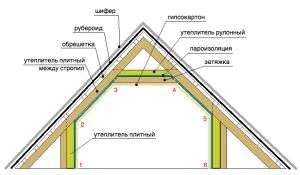
- Preparing a place for laying an insulating layer.
- Installation of thermal insulation material.
- Fixing the heater.
Even at the time of designing the rafter system, one should take into account the step in which the rafters will be installed.
Please note that the design must be reliable. Do not exceed recommended values
If the insulation was chosen at the stage of calculating the rafter system, then place the rafters so that the thermal insulation plates are well located between them from the inside. Everything should be tight. In this case, you will simplify the installation, and the amount of waste will be much less.
On top of the insulation in the area between the crate and the rafters, waterproofing is mounted. The material must be overlapped. It is recommended to start from the bottom edge of the slope.
Next, you need to mount wooden slats, the thickness of which will create the necessary gap for ventilation of the roof. You can fasten them with nails or screws. An insulating layer is laid and fixed on the prepared structure from the inside between the rafters.
Wood / metal rafters are a cold bridge, because the thermal conductivity of the material is much lower than that of the insulation.
Accordingly, it is additionally necessary to put a continuous layer of thermal insulation on top of the already mounted mats. For these purposes, the material of the same type, only thinner, is perfect.
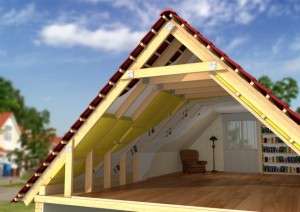
Lay a vapor-permeable film on top of the thermal insulation. It will help wick away excess moisture.The whole structure is fastened with a crate. The final stage is the interior decoration of the ceiling.
Summing up, we note that properly made insulation of the attic roof will allow you to use the attic space all year round for various purposes (including for living). Apply our recommendations in practice, and you will achieve your goal many times faster and better.
Do-it-yourself installation of mineral wool from the inside
The easiest way is to fasten the thermal insulation between the rafters on the inside of the roof structure. This technique will be effective only if the thickness of the insulation layer is less than or equal to the width of the rafters. Otherwise, you will have to resort to a combined method of roof insulation.
In this case, the procedure for insulating the roof with mineral wool will be as follows:
- First, it will be necessary to measure the lower tier of the rafters using the building level. This indicator should be uniform around the entire perimeter of the structure. If deviations are found, then the support will need to be leveled, ensuring that the rafters are in line.
- To protect the insulation from the negative effects of moisture, a waterproofing membrane is laid over the rafters. If you refuse to use it, the heat-insulating layer will not be reliably protected, which may shorten its service life.
- Roll insulation must be cut into fragments of the desired size. The material is fixed between the rafters by surprise. Based on this, the pieces of thermal insulation should be three centimeters wider than the space between the rafters. When laying the material in two layers, it must be ensured that the joints of the layers do not coincide with each other.
- The next step is the process of fitting the vapor barrier. The membrane is cut into strips, which are installed above the insulation layer. It allows you to protect it from moisture and air. The installation of the vapor barrier layer is carried out horizontally from top to bottom, after which it must be fixed with a construction stapler.
- The final stage is the finishing sheathing of thermal insulation. For this, edged boards, plywood or drywall boards are most often used. Upon completion of the work, this layer will become the basis for finishing the attic walls.
If the slope of the roof slopes is less than 25 degrees, this may lead to the following problem: the plates used for insulation may fall out, because the bursting force is not enough. To avoid this situation, it is recommended to additionally strengthen the insulation with battens or strong fishing line, which will be stretched between the rafters. If the ramp has a large slope, the likelihood of encountering such a problem is minimal.
